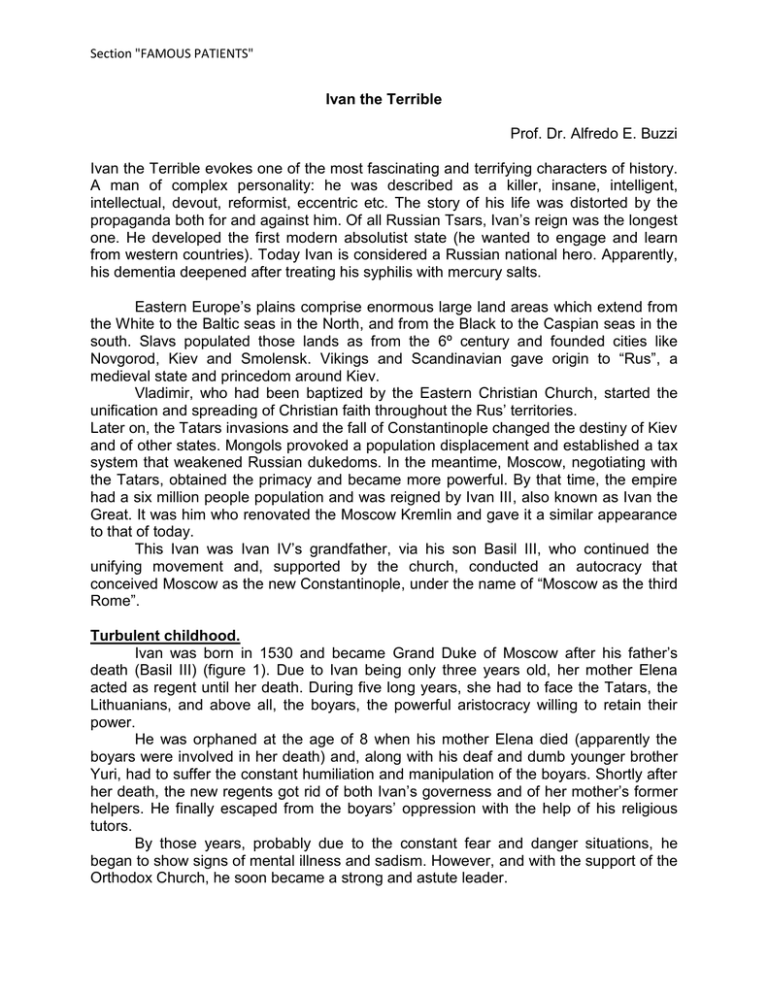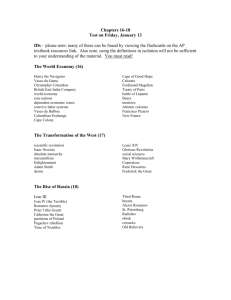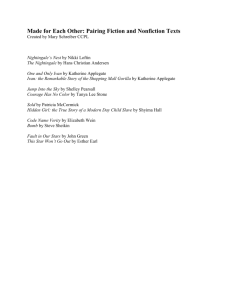Section "FAMOUS PATIENTS" Ivan the Terrible Prof. Dr. Alfredo E
advertisement

Section "FAMOUS PATIENTS" Ivan the Terrible Prof. Dr. Alfredo E. Buzzi Ivan the Terrible evokes one of the most fascinating and terrifying characters of history. A man of complex personality: he was described as a killer, insane, intelligent, intellectual, devout, reformist, eccentric etc. The story of his life was distorted by the propaganda both for and against him. Of all Russian Tsars, Ivan’s reign was the longest one. He developed the first modern absolutist state (he wanted to engage and learn from western countries). Today Ivan is considered a Russian national hero. Apparently, his dementia deepened after treating his syphilis with mercury salts. Eastern Europe’s plains comprise enormous large land areas which extend from the White to the Baltic seas in the North, and from the Black to the Caspian seas in the south. Slavs populated those lands as from the 6º century and founded cities like Novgorod, Kiev and Smolensk. Vikings and Scandinavian gave origin to “Rus”, a medieval state and princedom around Kiev. Vladimir, who had been baptized by the Eastern Christian Church, started the unification and spreading of Christian faith throughout the Rus’ territories. Later on, the Tatars invasions and the fall of Constantinople changed the destiny of Kiev and of other states. Mongols provoked a population displacement and established a tax system that weakened Russian dukedoms. In the meantime, Moscow, negotiating with the Tatars, obtained the primacy and became more powerful. By that time, the empire had a six million people population and was reigned by Ivan III, also known as Ivan the Great. It was him who renovated the Moscow Kremlin and gave it a similar appearance to that of today. This Ivan was Ivan IV’s grandfather, via his son Basil III, who continued the unifying movement and, supported by the church, conducted an autocracy that conceived Moscow as the new Constantinople, under the name of “Moscow as the third Rome”. Turbulent childhood. Ivan was born in 1530 and became Grand Duke of Moscow after his father’s death (Basil III) (figure 1). Due to Ivan being only three years old, her mother Elena acted as regent until her death. During five long years, she had to face the Tatars, the Lithuanians, and above all, the boyars, the powerful aristocracy willing to retain their power. He was orphaned at the age of 8 when his mother Elena died (apparently the boyars were involved in her death) and, along with his deaf and dumb younger brother Yuri, had to suffer the constant humiliation and manipulation of the boyars. Shortly after her death, the new regents got rid of both Ivan’s governess and of her mother’s former helpers. He finally escaped from the boyars’ oppression with the help of his religious tutors. By those years, probably due to the constant fear and danger situations, he began to show signs of mental illness and sadism. However, and with the support of the Orthodox Church, he soon became a strong and astute leader. Section "FAMOUS PATIENTS" Profoundly distrusting, Ivan soon understood that his future as a monarch was subject to defeating the boyars. At the age of 13, in an outburst of authority, he sentenced one of leaders of the group to death (Andrei Shuinsky) and had him killed by a pack of hungry dogs. The monk Macarius (figure 3), afterwards appointed Bishop of Moscow (and subsequently canonized as Saint Macarius of Moscow) was one the most influential members of the clergy during Ivan’s reign. He transmitted him a profound religiosity and the sense of having been summoned to develop a divine mission. And that was also due to the fact that Russia, or rather Moscow, after the fall of Constantinople, was the most Christian eastern territory, the barrier against the Turks and Tatars that were stalking from east and south. The cleric convinced him that he was a descendant of Rome’s Caesars, reinforced by the fact that his grandmother, Sofia Paleologo, had been a byzantine princess, nephew of the last emperor. This was rapidly and successfully spread within the reign. Such would be the reason for which, in 1547, he was crowned as Ivan IV as the first Russian Tsar (from the Slavic word, derived from Caesar), and not only as prince of Moscow but he claimed to be the success of the Eastern Roman Empire (figures 4 y 5). Moscow would be a third Rome and the church would accompany him in the enterprise. This union between Crown and Church, with all of it magnificence and ceremonial, would last up to the revolution of 1917. Two weeks after he was crowned Tsar of Russia, Ivan married Anastasia Romanova (figure 6), a sensitive and intelligent woman, who had a positive influence on him. In October 1552, Anastasia gave birth to a son, Dimitri, who died six months later, to Ivan, only nine months after Dimitri’s death and to Feodor in 1558. Dimitri apparently died affected by a congenital syphilis. Feodor was a simple minded man with little interest in politics. He was described as physically inactive, of overweight and short or medium height. Due to some illness in his legs he was unsteady on his feet. Though from a distance and with little information it is not possible to make an accurate diagnosis, Feodor probably also suffered from the congenital syphilis. The Reformist Tsar Taking into account today’s parameters, Ivan was a cruel tyrant. However for the Russia of that time and for European practices, he was a wise and humanitarian governor. From 1551 to 1560 he played a significant role in the decisions of his council, allowing freedom of speech and opinion and accepting the requests of all his subjects. According to legend, it was the first and sole time in the history of Russia when the country’s poor people had access to their Sovereign. After taking back power from his uncles, he created the “Rada” or private council in which his religious mentors had particular influence. He managed to fulfill almost all of his objectives: reconstructed Moscow, centralized and modernized the administration, updated legislation and for the first time summoned a group of general states to present petitions and complaints, strengthened the relationship with the Church, founded schools etc. Ivan also created units of guardsmen, the embryo of the future Russian military units. The “streltsi” (figure 7) was a group of three thousand men absolutely loyal to the Tsar, armed with axes and harquebuses (almost unknown in Russia up that moment) and whose services were paid with lands. All of these reforms had a common end: to Section "FAMOUS PATIENTS" reduce the influence of the hatred boyars and to push them away from the spheres of power. The external affairs policy’s objective was to eliminate the permanent Tatar threat. They decided to conquer large territories of Kazan in 1552 (figure 8), Astrakhan in 1556 and other territories of the Volga valley extending even to Siberia (figure 9). To this end, a strict policy of extermination and deportation of all Tatar population (all of them Muslims who were replaced by Russian settlers) was followed. The Orthodox Church compared Ivan with Alejandro Magnus, and to commemorate his conquers they built the Saint Basil Cathedral (figure 10), near the Kremlin. It is said that Ivan had the architects blinded to prevent them from building anything like it elsewhere. He failed to accomplish his second objective: establishing a stable port outlet to the Baltic. His goal was to come into contact with Western Europe scientific and cultural progresses. But he entered into conflict with Polish, Lithuanian and other Scandinavian countries’ interests that blocked the path because they feared the power the new Russian State could achieved. The constant wars throughout his reign produced limited results. Instead, they generated a tremendous economic cost and social discontent, of which opponents tried to take advantage. The only tangible successes were the introduction of printing and the instauration of sporadic commercial ties with England (figure 11). The Insane Tsar In the year 1560 his life took a dramatic turn. His mental problems increased notably, boosted by his excessive alcohol consumption, after his beloved wife Anastasia died. The authoritarianism, his rages and outbreaks, and his hilarious religious fanaticism took over his character and marked the future political events. He blamed the boyars on having poisoned Anastasia (they have already poisoned his mother) and on his counselors and friends for their lack of compassion towards her. Devoted to sadism, he embarked on a campaign of killings against his formers councilors of the Rada and their families and against any boyar considered a suspect. The death of both his brother Yuri and his old mentor Macarius, head of the Orthodox Church, deteriorated the situation further. Macarius was replaced by Afanasy who dared to ask him to moderate cruelty and despotism. A year later, a new setback affected him: prince Andrei Kurbsky, hero of the war against the Tatars and one of Ivan’s main advisors, more and more afraid of Ivan`s dangerous outbreaks, defected to the Polish- Lithuanians’ side. In 1564, in the middle of an attack perpetuated by the traitor Kurbsky, fearing a general rebellion on behalf of the boyars, Ivan left Moscow with his family, treasures and followers (supported by some sectors within the Church) and settled in Alexandrovskaya. From there (figure 12), at 120 km away from the capital city, he wrote letters to bishop Afanasy, to the nobility and to the people of Moscow. In those letters he accused noblemen of corruption and abuse of power and he explained the reasons for which he wanted to abdicate. The reaction was immediate: the population called for his return fearing both social upheaval and Polish invasion. Both the boyars and the church urged him to come Section "FAMOUS PATIENTS" back. Ivan agreed to come back but on his own terms, demanding absolute power to punish anyone he believed disloyal. As soon as he came back he divided the realm in two: a part that maintained the old administration, where boyars still had a significant influence, and the Oprichnina (Russian word that means “separate”) an area in the northeast of Russia. In those territories he had unlimited power, thus boyars were obliged to emigrate. The system called the “oprichnik” (figure 13) was a police force composed by soldiers and members of the church that acted with extreme cruelty, torturing and killing all those accused of disloyal. They dressed in total black with golden touches and rode black steeds. Their caps’ flagship was the cadaver of a dog and a broom: bit betrayal, be loyal and sweep Russia. For seven years, the police force accumulated over six thousand men that operated with total immunity. Thousands of boyars, churchmen, soldiers and anyone suspected of treason were exterminated. It was precisely this repression what prevented a powerful feudalism was implemented in Russia like in other parts of Europe. Since then, the country would remain in the hands of an absolute monarchy, strongly centralized, which very few states dared to defy. It was evident that with the unleashed oppression the power of the nobility had considerable reduced. Meanwhile, the everlasting wars against Polish and Lithuanians were generating a progressive deterioration. In 1570 he headed for Novgorod, suspecting the city’s authorities had been cooperating with Lithuania. The killing of more than 15.000 people lasted five weeks (figure 15). In Moscow, the evil oprichnik continued bringing death and massacres against boyars and sacking the city arbitrarily. The state of terror and the poor harvests affected the collection of taxes, weakening the state even further. Crimean Tatars took advantage of this situation and leaped on to Moscow while Polish and Lithuanians recovered the territories previously lost. Ivan’s dementia took him to believe the Oprichnik had also betrayed him and blamed them on poisoning his third wife and on conspiring with the enemy. He even ordered the execution of several generals. The Oprichnik was abolished within a short period of time. The killer Tsar Ivan IV’s dementia became visible during the last decade of his reign (figure 16) and it was accompanied by his progressive tendency to alcoholism. He lived in religious mysticism outbursts, devoting countless hours to praying, hitting and chastising himself at the altars (figure 17), and ordering all sort of killings and sadistic perversions which, occasionally, he himself perpetuated. The execution of noblemen suspected of treason was followed by the killings of their widows and children, after they had been subject to tortures and sexual abuses. Apparently, after each criminal action he committed in anger, he was assaulted by a deep feeling of remorse. Subsequently he confined for days in churches and monasteries to purge his sins, though before long he returned to the old ways (figure 18). Obviously, Polish historians greatly boosted his criminal actions, and invented many others. However, due to the murderous insanity condition in which he was, all of them were credible, reason for which Western Europe forged a very repulsive image of Section "FAMOUS PATIENTS" the Tsar (figure 19). In those years, he became known by the name of Grozny, “The Terrible”, though some say the correct translation would be “the Severe” or “the Feared” (figures 20 and 21). History tells that in a trip to England he became interested in visiting the Tower of London to learn from its torture instruments. When shown “the wheel”, he was explained that he would not be able to witness the use of the torture device as no criminal had been sentenced to death. He responded: “Use one of my men. I want to see the demonstration”. Legend claims that the Tsar had an insatiable sexual appetite. True or not, and apart from possible and sporadic mistresses, eight wives are documented. The first one was Anastasia (herein before mentioned) with whom he had three children: the first one died very young, he killed his second son by striking him in the head, and a third one that survived and succeeded him. His second wife was Maria Temryukovna (figure 22) to whom he poisoned. The third one was Marta Vasilyevna Sobakina who was found dead two weeks after they wed. His fourth wife, Ivanovna Koltovskaya, was lucky enough to be sent to a convent almost two years after their wedding. His fifth wife was Ana Grigorievna Vasilchikova, who was also locked up in a monastery. His sixth wife, Vasilis Melentyeva (figure 23) was discovered having an affair. She saved her life by being confined in a cloister (figure 25) and his lover was impaled (figure 24). Maria Dolgorukaya, his seventh wife, was accused by the Tsar of not being virgin and she was asphyxiated the day after the wedding. His last wife, Maria Feodorovna Nagaya, had the merit to survive him. In 1580, in an anger outburst, Ivan struck with his iron staff the head of his son and heir, Ivan, who finally died after three agonizing days (figure 26). In deep sorrow and regret, Ivan IV pulled out his bear and hair, peeled off his nails against walls and spent night after night howling in halls. As penance, he decided to write personally a list of the thousands of men he had ordered to execute. The idea was to send it to all churches and monasteries along with large sums of money to be invoked in prayers and mass for their soul salvation. His health deteriorated the same as his limited lucidity. In that period he became obsessed with marrying Isabel I, or any princess of England, to reinforce ties with the sole western reign that showed him a certain interest. Queen Elizabeth I of course ignored his proposition. Hi last months were hilarious: surrounded by wizards who predicted the date of his death; stroking his jewels which he believed had mystic healing powers and being more and more delirious. The only event worth mentioning was the expansion up the Obi river basin: Cossacks occupied the Khanate of Sibir, then to be called Siberia. Ivan died in March, 1584 while playing chess (figure 29). He was buried in the Kremlin, in the Archangel’s Cathedral. He was succeeded by his son Feodor I (figure 30) who died childless in 1598. Feodor’s death marked the end of the Rurik dynasty (Muscovite line) that descended from Ivan I of Russia (Ivan Kalita). As from then onwards Russia was ushered in the so called Times of Trouble. The cause of his disorder Section "FAMOUS PATIENTS" Ivan’s vassals believed that the Tsar was the physical presence of God on earth and thus did not conceive the idea of a disease affecting him. On the contrary, they interpreted his atrocities as God’s punishment for the “multiplication of sins within Orthodox Christians”. With the same conception, they later on interpreted that God became angry with Ivan and that, through Feodor (his successor), had sent mercy to the people. Feodor was considered a “sacred fool”. Many diagnoses have been tried to explain Ivan the Terrible personality. From the psychological point of view, dysphoria periods might represent a pure depressive disorder; religiousness and philosophic worries, paranoia; verbosity, neurosis; emotional changes, hysteria or borderline personality disorder if we consider violence and suicidal attempts. Anger outbursts and sudden emotional changes, hyper religiosity and a certain sense of “personal destiny” gave origin to the controversial temporal lobe personality that has been related to temporal lobe syndrome as it is associated to temporal lobe epilepsy. The truth is that the syphilis and its treatment based on mercury salts, conspired against the Tsar’s insanity. During the soviet regime Ivan’s remains were exhumed in the Kremlin. It was demonstrated they had the typical bone lesions produced by such disease. At the age of 23, Ivan had been seriously ill with high fever and that could have been the onset of his syphilis, which he transmitted on to all his descendants. The syphilis lesions were combined with the damaged produced by the treatment used on that period: mercury salts. There was a classic saying:” One night with Venus a lifetime with Mercury”. The damage produced by mercury was even more severe than the disease itself, with symptoms such as sudden mood changes, anger outburst and psychotic manias. Therefore, the progressive deterioration of his personality was the result of both the evolution of the disease and the ongoing treatment with mercury salts. The high mortality within his children and the defects within those that survived only reinforce the theory. Apparently, his heir Feodor, had also been born with the disease (congenital syphilis), and his physical aspect and countenance clearly denoted he was mentally retarded. Due to his lack of interest in politics he left Boris Godunov, a former boyar and member of the oprichnik, to rule in his name. Apparently, Feodor’s sole interest included praying and ringing bells at churches and that is why he is sometimes called the “Ringbeller”. The death of his only daughter maddened him in sorrow. His failure to sire other children brought an end to Rurik dynasty that had been ruling Russia since the year 862. He was succeeded as tsar by Godunov (figure 31). Bibliography Appleby J. Ivan the Terrible to Peter the Great: British formative influence on Russia’s medico-apothecary system. Medical History, 1983, 27: 289-304 Cartwright F., Biddiss M. Grandes pestes de la historia. Editorial El Ateneo, Buenos Aires, 2005 De Madariaga I., Ivan the Terrible: First Tsar of Russia. Yale University Press, London, 2005 Section "FAMOUS PATIENTS" Dewey H. Some perceptions of mental disorder in pre-petrine Russia. Medical History, 1987, 31: 84-99. Dickson Wright A. Venereal disease and the great. Brit J Vener Dis 1971, 47: 295-306 Espinoza R., Benavides E. Ivan IV, el Terrible, ¿padeció de un síndrome del lóbulo temporal? Rev Méd Chile 2006; 134: 1465-1469 Hellmann M, Goehrke C, Scheibert P, Lorenz R. Historia Universal. Siglo XXI Editores. Mexico, 1975 Ibáñez Fos M.C. Ivan "El Terrible" en la historiografía rusa y soviética. Revista de Historia Medieval 1993, 4:275-290 Newell R. Pain and Cruelty. California Medicine 1965, 103: 208-211









